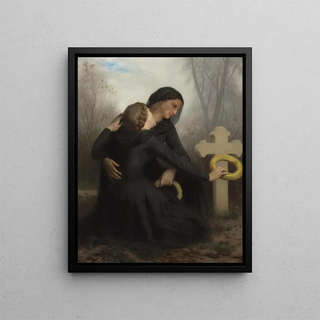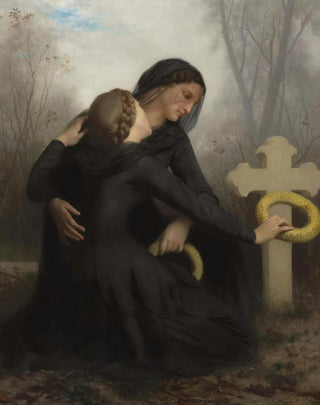Art print | The Day of the Dead - William Bouguereau


View from behind

Frame (optional)
In the rich and complex universe of art history, some works manage to transcend time and touch the human soul profoundly. "The Day of the Dead" by William Bouguereau is one of these masterful pieces that evoke a multitude of emotions and reflections. This artwork, which immerses the viewer in an atmosphere that is both melancholic and serene, invites contemplation of universal themes of life and death. The poignant depiction of the characters, the delicacy of their expressions, and Bouguereau's technical mastery make this canvas a true masterpiece, demonstrating the importance of memory and respect for ancestors.
Style and uniqueness of the work
William Bouguereau's style is often associated with rigorous academic technique, which is evident in "The Day of the Dead." The artist, known for his ability to capture human beauty with almost photographic precision, uses soft colors and subtle play of light to create an atmosphere that is both intimate and solemn. The figures, portrayed with striking realism, seem to engage in dialogue with the viewer, their gaze filled with emotion. Bouguereau manages to convey psychological depth to his characters, making their experience universal. This painting, far from being a simple representation of death, asserts itself as a celebration of life and memory, where every detail, every gesture, tells a story.
The artist and his influence
William Bouguereau, an emblematic figure of the 19th century, marked his era with his commitment to academic art, while striving to modernize painting conventions. Raised in an artistic environment, he knew how to combine tradition and innovation, becoming one of the most admired painters of his time. His influence is felt not only through his works but also through his students, who carried on his legacy. Bouguereau was able to capture the essence of the human condition, addressing themes such as motherhood, suffering, and spirituality. "The Day of the Dead" fits into this quest for understanding and representing humanity, bearing witness to his exceptional talent and capacity.

Matte finish

View from behind

Frame (optional)
In the rich and complex universe of art history, some works manage to transcend time and touch the human soul profoundly. "The Day of the Dead" by William Bouguereau is one of these masterful pieces that evoke a multitude of emotions and reflections. This artwork, which immerses the viewer in an atmosphere that is both melancholic and serene, invites contemplation of universal themes of life and death. The poignant depiction of the characters, the delicacy of their expressions, and Bouguereau's technical mastery make this canvas a true masterpiece, demonstrating the importance of memory and respect for ancestors.
Style and uniqueness of the work
William Bouguereau's style is often associated with rigorous academic technique, which is evident in "The Day of the Dead." The artist, known for his ability to capture human beauty with almost photographic precision, uses soft colors and subtle play of light to create an atmosphere that is both intimate and solemn. The figures, portrayed with striking realism, seem to engage in dialogue with the viewer, their gaze filled with emotion. Bouguereau manages to convey psychological depth to his characters, making their experience universal. This painting, far from being a simple representation of death, asserts itself as a celebration of life and memory, where every detail, every gesture, tells a story.
The artist and his influence
William Bouguereau, an emblematic figure of the 19th century, marked his era with his commitment to academic art, while striving to modernize painting conventions. Raised in an artistic environment, he knew how to combine tradition and innovation, becoming one of the most admired painters of his time. His influence is felt not only through his works but also through his students, who carried on his legacy. Bouguereau was able to capture the essence of the human condition, addressing themes such as motherhood, suffering, and spirituality. "The Day of the Dead" fits into this quest for understanding and representing humanity, bearing witness to his exceptional talent and capacity.






